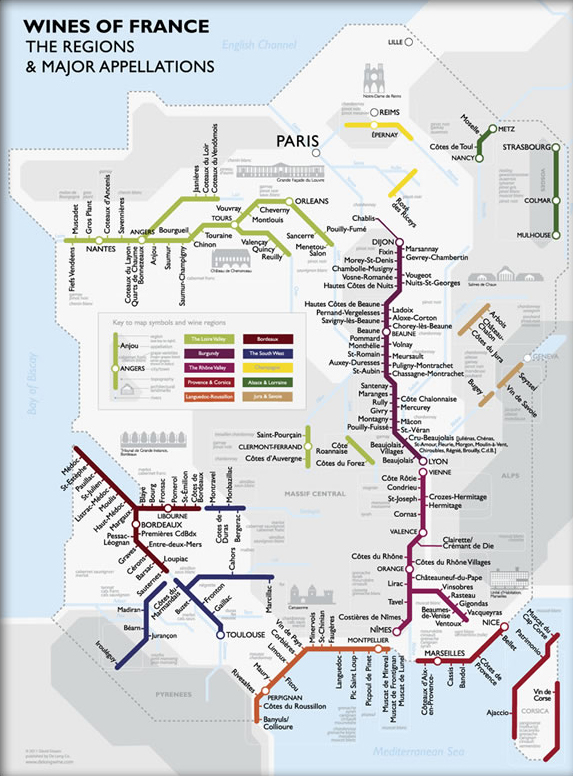Launched in 2004, the Ask Dr. Map web site contains answers to questions about maps submitted to Dr. Map, the “anonymous” author of the column Ask Dr. Map, printed bi-monthly in the ACSM Bulletin. The following column, titled “That which we call a rose,” is from the October 2011 ACSM Bulletin, available online later this month:
Dear Dr. Map: Are there maps that can help me understand French wines?
A: Cartography has long been centered on the sense of vision, but there are four other senses, and long neglected has been that of gustaoception, or taste. While geography has occasionally ventured into the world of viniculture (for example, Wine: A Geographic Appreciation by Harm J. De Blij), other than the occasional wine stain on a map, there has been little to expand on the usually gaudy guide maps to wine country. However, Dr. Map recently ran across the extraordinary Metro Wine Map, designed by Dr. David Gissen. This map covers the French wine districts, and the “appellations.” The twist is that the map uses the technique pioneered by Harry Beck in the 1930s for the London underground map. Wine districts are colored “lines,” with branches showing the different appellations. One can clearly see, for example, the link between Pouilly-Fumé and Vouvray, both from the Loire Valley, but with the former made from the Sauvignon Blanc grape variety and the latter Chenin Blanc. They are both on the “Green Line.” Some districts are curious little isolated train lines, others cross whole swaths of the country. I would not use this map to negotiate the back roads of Bordeaux, but it would work quite well at the local wine store.
Dear Dr. Map: Have there ever been maps of smells?
A: Such a Japanese website was recently featured on Google Maps Mania. This user-contributed site allows anyone interested to post what look like cylindrical balloons on a world map, with bubbles that describe smells located there. Since Dr. Map’s Japanese is a little rusty, I’ll simply have to quote Google Maps Mania in noting that labels favor “men, badgers, foxes, watermelon and pets.” The one African smell is “zebra.” One unpleasant smell is labeled “drool.” Dr. Map notes that computers have broadened out to include sight (even 3D), sound, and, in some cases, touch. I don’t see any available “smell” cards for my PC yet. Perhaps there is a market just waiting to be exploited? Meanwhile, hold the drool smell, thank you very much.
Dear Dr. Map: Are there web maps that I can listen to?
A: Cartography has dabbled in using sound on many occasions, but the ease with which sounds can be incorporated into online and digital maps has led to a boom in carto-audioception. There are too many to review them all, but Dr. Map notes the variety of accents and voices available for car GPS navigation systems (Tom Tom, for example, offers an 11 year old female using Valley-Speak), the cell phone guide app that lets users contribute spoken information, the global sound map, with and without sound samples, and the noisiest site that includes the sound-seeker map of New York, including passing subway trains. Had enough sound? Check out the site where users can report places where you can find perfect silence. Now that’s something to shout about!
Dear Dr. Map: Where can I get a map of last names?
A: The February issue of National Geographic contained a map of last names, surnames, that were most common by small areas in the US, color coded by country of origin. The source of the map was a group of researchers at University College London who have two major projects involving last names, both of them with interactive on-line web sites. At one, the British censuses of 1881 and 1998 are available, and you can enter a name and create a map of the distribution of people with that last name. Dr. Map was amazed to see that the name Mapson, appropriate perhaps for his next of kin, is mostly found in the west of England, and is absent from London entirely! For the broader picture, the site allows global mapping, see: worldnames.publicprofiler.org. What’s in a name? A map, apparently.

.jpg)




